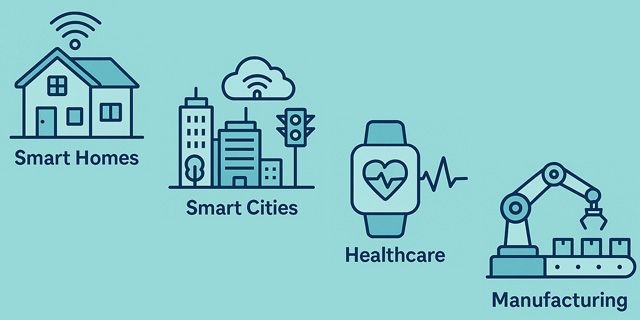The combination of AI (Artificial Intelligence) and IoT (Internet of Things) — known as AIoT — is no longer just a buzzword. It’s already transforming industries, improving daily life, and shaping the future.
In this article, you’ll discover how AIoT is being used in the real world, across homes, cities, factories, hospitals, and more.
1. What Makes AIoT So Powerful?
Before diving into examples, let’s recap what makes AIoT different:
- IoT connects devices and gathers data.
- AI analyzes data and makes decisions.
- AIoT does both — enabling real-time, automated actions based on intelligent insights.
This leads to smarter, faster, and more efficient systems.
2. Smart Homes: Making Everyday Life Easier
2.1. Smart Thermostats
AIoT-enabled thermostats can:
- Learn your schedule and temperature preferences.
- Adjust automatically to save energy.
- Detect if you’re home or away using sensors.
2.2. Smart Security Systems
Modern AIoT security cameras can:
- Recognize familiar faces (like family members).
- Detect motion, sound, or suspicious activity.
- Send alerts or activate alarms instantly — without human input.
2.3. Voice Assistants + Smart Devices
Devices like Amazon Alexa or Google Assistant, when paired with smart appliances, form an AIoT ecosystem. For example:
- “Turn off the lights when I leave.”
- “Start the coffee machine at 7 AM.”
- “Lock the doors if no one is home.”
3. Smart Cities: Making Urban Life Safer and Smarter
3.1. Traffic Management
AIoT traffic systems use cameras and sensors to:
- Detect congestion in real time.
- Adjust traffic lights dynamically.
- Reduce travel time and pollution.
3.2. Waste Collection
Smart bins monitor their fill levels and use AI to:
- Notify waste services when they need to be emptied.
- Plan the most efficient collection routes.
3.3. Public Safety
- AIoT surveillance systems can spot unusual behavior.
- Automatically alert law enforcement when needed.
4. Healthcare: Improving Patient Outcomes
4.1. Wearable Health Devices
Smartwatches and health bands do more than count steps. With AIoT, they can:
- Monitor heart rate, oxygen levels, and sleep quality.
- Detect irregular patterns and warn of potential health issues.
- Share data with healthcare providers in real time.
4.2. Remote Patient Monitoring
Hospitals use AIoT systems to:
- Track vital signs of patients at home.
- Alert doctors if any sudden changes occur.
- Help manage chronic conditions more effectively.
5. Manufacturing & Industry: Boosting Productivity
5.1. Predictive Maintenance
AIoT sensors on machines can:
- Monitor temperature, vibration, and performance.
- Predict when a machine is likely to fail.
- Schedule maintenance before breakdowns happen — saving time and money.
5.2. Smart Robotics
- Robots use AI to adapt to new tasks.
- IoT connectivity keeps them updated and responsive.
- Used in tasks like packaging, quality control, or working alongside humans.
6. Agriculture: Smarter Farming with AIoT
- Soil sensors measure moisture and nutrients.
- AI algorithms determine the best time to water or fertilize.
- Drones collect data on crop health and help optimize yields.
Result? More food, less waste, and better sustainability.
7. Retail: Enhancing Shopping Experiences
- AIoT cameras track customer movement and behavior.
- Stores can adjust product placement or lighting in real time.
- Smart shelves know when items are out of stock and trigger restocking.
8. Conclusion
From your living room to the factory floor, AIoT is everywhere — making systems faster, smarter, and more responsive.
By combining connectivity with intelligence, AIoT applications are revolutionizing how we live and work. And this is just the beginning.


